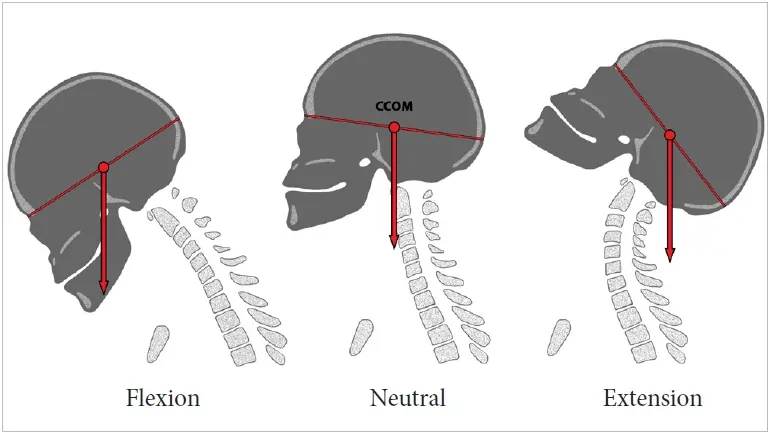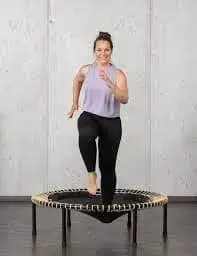Neck Flexion
What Is Neck Flexion?
Neck Flexion is a simple movement where you gently lower your chin toward your chest, creating a stretch along the back of your neck.
This motion helps improve neck mobility, relieve tension, and counteract the effects of prolonged sitting or looking down at screens. It’s a foundational stretch in many rehabilitation and wellness routines.
Deep neck flexor muscles and the sternocleidomastoid (SCM) muscle are used in this joint, which is located directly beneath the skull.
The following are additional neck movements:
- The other neck movements are:
- Neck Rotation: rotated from side to side
- Neck Side Flexion: bent laterally to bring the ear to the shoulder
- Neck Extension: extended to raise the chin.
The goniometer is a device that measures the usual range of motion in neck flexion, which is 40 to 80 degrees. This illustrates how much movement your neck can withstand without causing pain, discomfort, or resistance.
The maintenance of a normal range of motion is facilitated by healthy bones, muscles, and joints.
Causes Of Pain, Tightness & Decreased Mobility
The causes of impaired or limited neck flexion vary, but they typically entail activities that demand frequent looking down. It is referred to as text neck when it results from staring down at a handheld device.
The following activities may result in stiff necks and restricted range of motion:
- usage of a computer and phone
- reading
- driving, prolonged sitting
- cycling, walking, particularly on uneven terrain
- sleeping improperly
- stitching, sketching, or writing
- toting a large shoulder bag
- sports requiring repetitive upper body movements
- and sports involving one side of the body
Exercises for improving Neck Flexion
The exercises shown below strengthen and relieve pain while increasing your upper back and neck range of motion. Both standing and sitting are acceptable for these workouts.
Don’t push yourself; instead, move slowly and deliberately. To ensure proper alignment and posture, move your neck while keeping the rest of your body still.
Neck flexion stretch
This exercise will assist relieve tension in your posterior neck muscles.
- To keep your spine stable, place your arms next to your body and contract your core.
- Lower and bring your shoulder blades back.
- Wait 15 to 30 seconds.
- Perform two to four reps.
at the base of your skull with your fingertips to direct the Put one hand behind your head to extend this farther.
Neck Retraction
In addition to relieving pain and lowering spinal pressure, this exercise relaxes tense muscles. Be sure to maintain a forward gaze throughout.
- The back of your neck feels like it’s becoming stretched.
- Complete 3–4 sets of 8–10 repetitions at once or over the course of the day.
Exercises For Improving Lateral Bending
Your shoulders and neck sides can be stretched with these workouts.
Ear-to-shoulder stretch
- To keep your spine straight, pull your shoulder blades back and down and tense your abdominal muscles.
- To get your right ear closer to your right shoulder, progressively bend your neck while keeping your shoulders in the same position.
- Five to 10 seconds of holding.
- Perform with your left side.
Scalene Stretch
- You start to sit or stand, keeping your arms by your sides.
- Maintain a straight spine by contracting your abdominal muscles and pulling your shoulder blades back and down.
- Slowly bend your neck to bring your right ear closer to your right shoulder while keeping your shoulders stable.
- Hold for five to ten seconds.
- Use your left side to perform.
How to Stretch Your Neck
Although a stiff neck isn’t typically an indication of a serious condition, you don’t have to put up with it.
Whether your neck is stiff from spending too much time in front of a screen or from bending forward when cleaning or gardening, you’re undoubtedly trying to find a solution.
Thankfully, there are numerous methods for stretching your neck to ease the discomfort and stiffness that might accompany headaches, restricted mobility, and muscle spasms.
Continue reading to learn about some of the most helpful stretches you can incorporate into your routine and some of the reasons why your neck can be stiff.
Why Your Neck Is Stiff
Neck pain and stiffness can result from a number of commonplace causes, including bad posture, prolonged sitting, and activities like riding a bike, reading, or driving.
Another common consequence of looking at your device is a computer, tech, or text neck.
Osteoarthritis pinched nerves, and strained muscles are additional reasons for neck discomfort. Another factor that might cause neck pain is injuries sustained in sports and motor accidents.
Meningitis, cancer, and rheumatoid arthritis are among the illnesses that can exacerbate neck discomfort.
Useful Stretches
Perform these exercises at least once a day as part of a larger routine. They can also be divided into 5-minute sessions that you can do throughout the day.
If you have a sensitive neck, proceed with the stretches slowly and carefully. Try to stretch as far as you can without exerting yourself.
Feeling some sensation is normal, but if you feel discomfort, stop right once. Consult a physician if the stretches don’t seem to be helping or if you think you might have hurt yourself.
Chin Tilts
If allowing your head to fall back is difficult for you, support it with a cushion, wall, or prop.
- Take a comfortable seat or stand to start.
- Allow your head to fall back while tilting your chin upward.
- Hold for a maximum of 30 seconds.
- Go back to the starting position slowly.
- Repeat two to four times.
Neck Rotation
One technique to increase your range of motion is to stretch the sides of your neck. Throughout the exercise, maintain your hips and shoulders pointed forward.
- Rotate your neck slowly to the right.
- Look over your shoulder.
- To make the movement more profound, gently press your chin in.
- Hold this posture for a maximum of 30 seconds.
- Go over the other side.
Standing Forward Bend
By holding this stance, you can relax your neck, back, and head. You’ll also relax your legs and spine. This stretch may be deepened by bending your knees and placing your palms beneath your feet, palms facing up.
- Place your feet hip-distance apart or a little wider in between.
- In order to descend your torso toward your legs, hinge at the hips.
- Make sure your knees are comfortably bent.
- Your hands are on the floor.
- Whatever direction seems comfortable, move your head.
- Hold for a maximum of one minute.
- The starting position is reached by pressing yourself up with your hands on your thighs.
Cat-Cow Pose
You can release tension in your head, neck, and back by incorporating neck flexion and extension into the Cat-Cow Pose. Additionally, it encourages proper posture and body consciousness.
- Start on all fours and take a table position.
- Take a breath to make your tummy bigger as it falls to the floor.
- Hold your head back a little, raise your chin, and look up.
- Relax by moving your head in any comfortable posture.
- At your own pace, go from here between the lower and top positions.
- The action should be guided by your breath.
- For a minimum of one minute, keep going.
Sphinx Pose
This position helps to support proper posture by strengthening and lengthening your spine. Additionally, it helps treat computer or text neck issues.
- Your elbows should be right beneath your shoulders when you lie on your stomach.
- You may raise your head and chest by using your thighs, glutes, and lower back.
- Gaze straight up at the ceiling or up a little.
- Hold for a maximum of one minute.
- Repeat one or three times.
Bed Hangs
Repeatedly staring or bending forward can cause imbalances, which this stretch helps to address, relieve tension, and increase circulation.
- Reposition your head gently over the bed’s edge.
- Your hands should be placed beside your body or over it.
- For a maximum of one minute, maintain this posture.
- Return your head gently to the bed and let yourself unwind in this position.
- Repeat one or two times.
FAQs
How to test neck flexion?
Ask the subject to gently bring their chin down to their chest in order to evaluate neck flexion. Examine the range of motion and look for any restrictions or discomfort.
What is the ROM of neck flexion?
It is considered typical for the cervical flexion to be about 80 degrees. Ask the patient to look as high up as they can until their neck is fully extended in order to measure cervical extension. The typical cervical extension is 50°.
How should a healthy neck look?
You may initially believe that in order for your neck to be correctly aligned, it must be exactly straight. But in fact, the neck needs some curve! Your neck should be properly bent in the middle when you are in this position.
How to test neck flexibility?
To test your neck’s flexibility, swivel your head to one side while sitting in a chair or on the ground.
References
- Cronkleton, E. (2019, September 9). What is neck flexion? plus exercises for improving your range of motion. Healthline. https://www.healthline.com/health/neck-flexion
- Patel, D. (2023, July 22). Cervical flexion and extension – anatomy, ROM, movement. Samarpan Physiotherapy Clinic. https://samarpanphysioclinic.com/cervical-flexion-and-extension/
- Cervical Deep Neck Flexors, https://www.physio-pedia.com/Cervical_Deep_Neck_Flexors.







